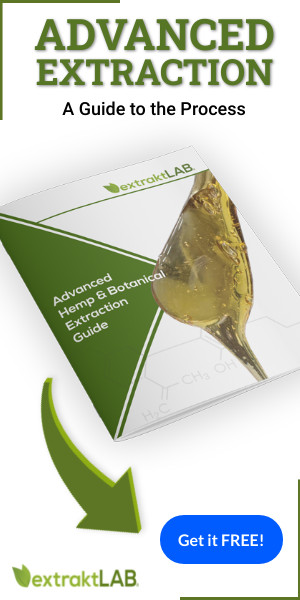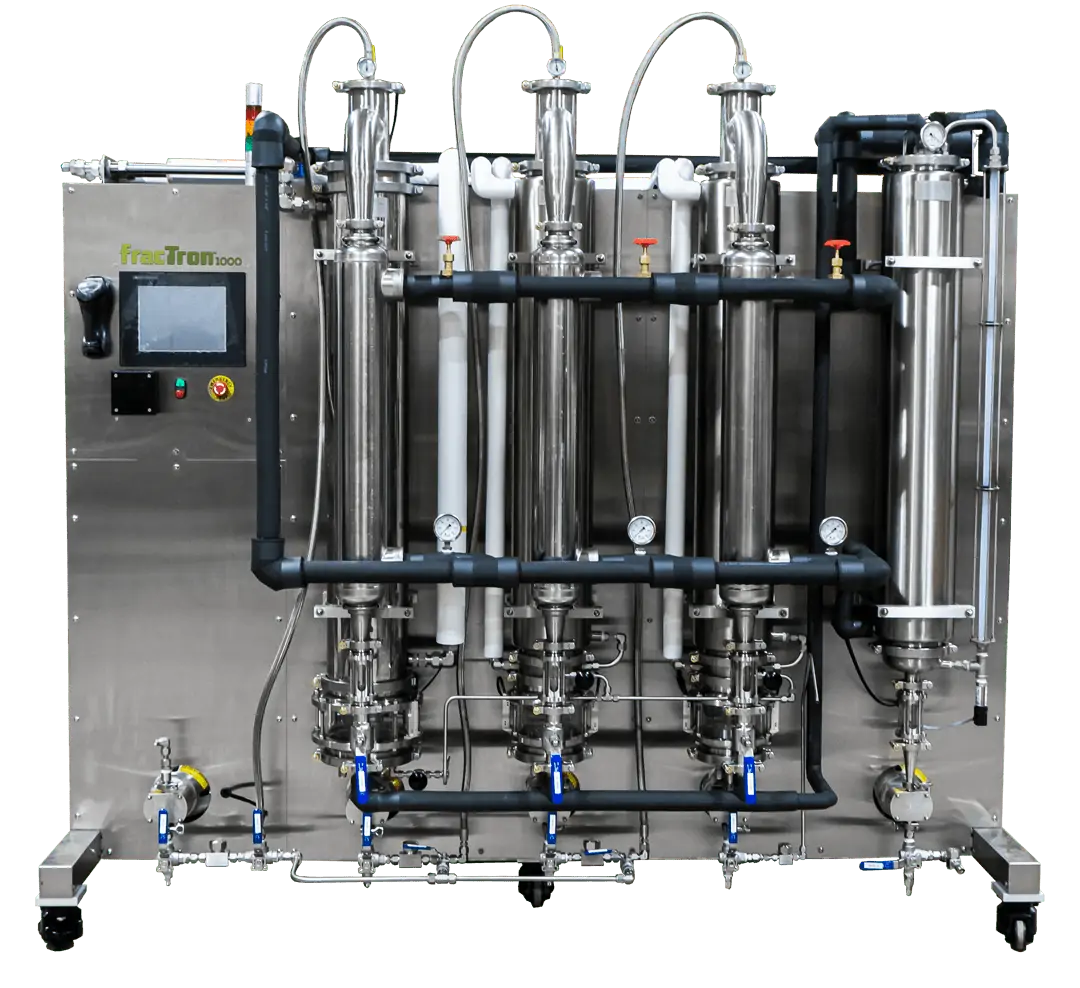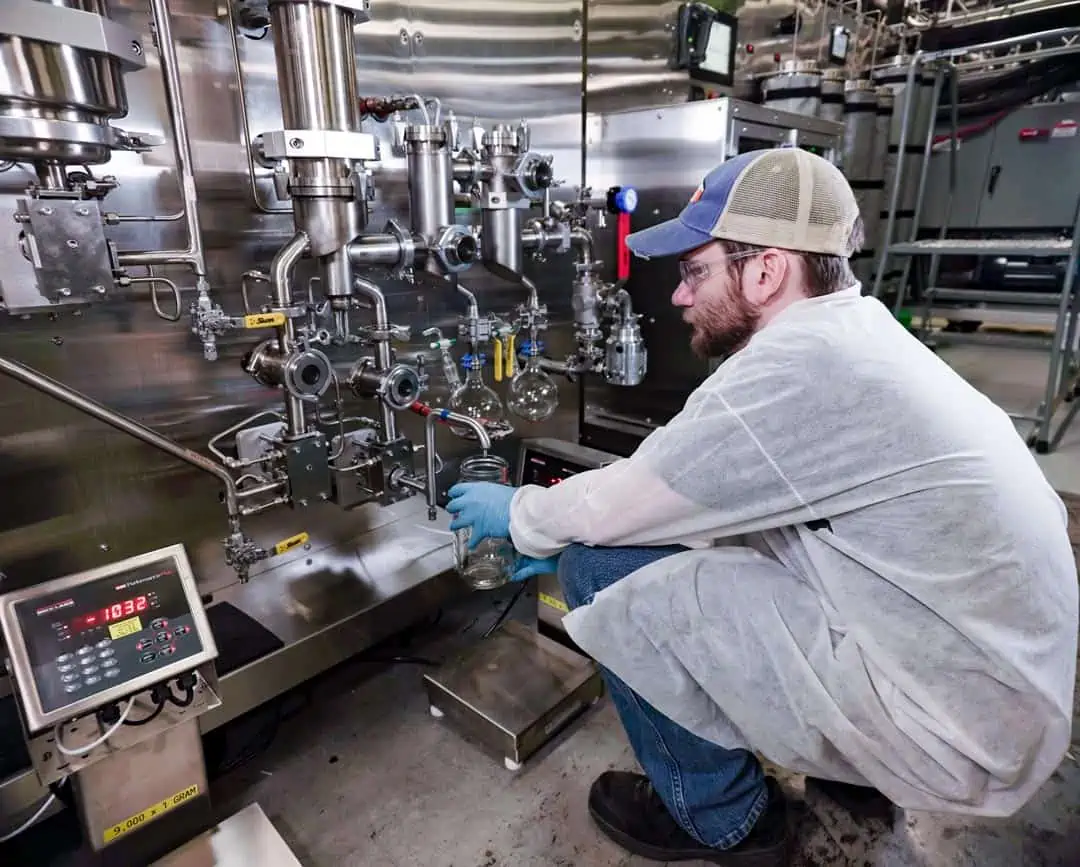CBD Post Processing: The Necessary Steps After Extraction
Unless you are selling wholesale crude oil to other businesses, there are several post extraction processes that need to be followed in order to make a cannabinoid derivative product. Making distillates or isolates requires further processing after the initial extraction to ensure that all the solvent and other impurities are removed before it can be formulated into a final product. If you are looking for more information about everything you need to know about extraction, take a look at our supercritical CO2 extractor page to look at all our info about CBD extraction. If you’re looking to find the best info on CBD post extraction, this page will walk through the post extraction processes necessary to make high quality extraction products.
What are the Steps of Post-Extraction?
Whether you are extracting with ethanol, hydrocarbon or CO2, you need to take the next steps to create a high quality extract. The oil that comes from your extraction still contains fats, waxes, solvents and other traces of materials that do not make for a product that goes on the shelf. In order to create a product that your customers want, you have to refine your oil. Let’s take a look at each of these steps in detail.
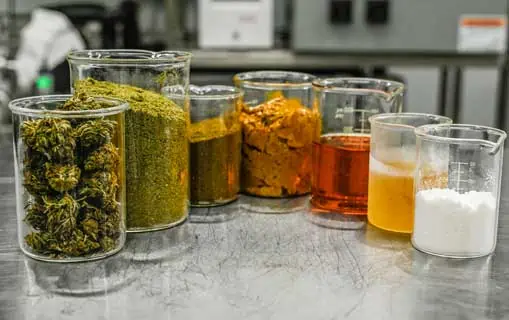
The Five Steps of CBD Post Processing
- Winterization & Filtration: This process takes the fats and waxes that come from the extraction process and removes them from the oil. This is performed by combining the oil with food grade ethanol, chilling the mixture down to sub-zero temperatures and then filtering the mix through a vacuum filtration system.
- Solvent Removal: Whether using CO2 or ethanol extraction, the solvent needs to be removed from the mixture before it can be formulated. This is done with evaporation equipment that uses heat, vacuum pressure and thin film technology to remove the solvent through evaporation while leaving the oil intact.
- Distillation: Solvent removal does a great job of removing large amounts of extraction or winterization solvent, there is further refinement necessary through distillation. This process uses the same methods of heat, vacuum pressure and thin film, but uses a mechanical wiped film method to create the thin film needed for evaporation due to its increased viscosity.
- Chromatography: This process is used to separate various components from a solution. Not only is it important for remediating psychoactive components, pesticides and other undesired materials from an extract, it is also a reliable and safe testing method to avoid potential contamination in a final product.
- Isolation: This method is the process of removing all other components from an extract and leaving only the desired cannabinoid. This is done by applying heat, increasing stir rate, and then performing a solvent wash to create a pure cannabinoid crystal or powder to be used for product formulation.
Winterization & Filtration
Winterization is a process that chills the extract mixture down before filtering in order to remove the fats and waxes from the oil. Because the fats and waxes from the plant are less soluble at lower temperatures, they are more easily filtered out of the cannabinoid and terpene rich oils that are desired.
This process is performed by combining the crude oil with food grade ethanol and then chilled down to -20 degrees Celsius. Once the fats and waxes have collected under the cold temperatures, winterized oil is added to a vacuum filtration system that will pull the oils intended for product formulation through a filter media leaving all the excess plant materials behind.
This is an important step in the process primarily for end user satisfaction. The fats and waxes when left in the extracts can cause irritation when vaporized, flavor issues, consistency problems, etc. This applies to all the intended end products created from plant extracts.
There are other issues associated with these extracts if this process is not performed correctly. Not only do flavor and consistency become impacted by these plant materials, clarity is impacted as well. A clear golden distillate is a benchmark of a high quality extract that consumers are well aware of. Leaving fats and waxes in the final extract can cause a cloudy, discolored distillate that would be undesirable to the end user.
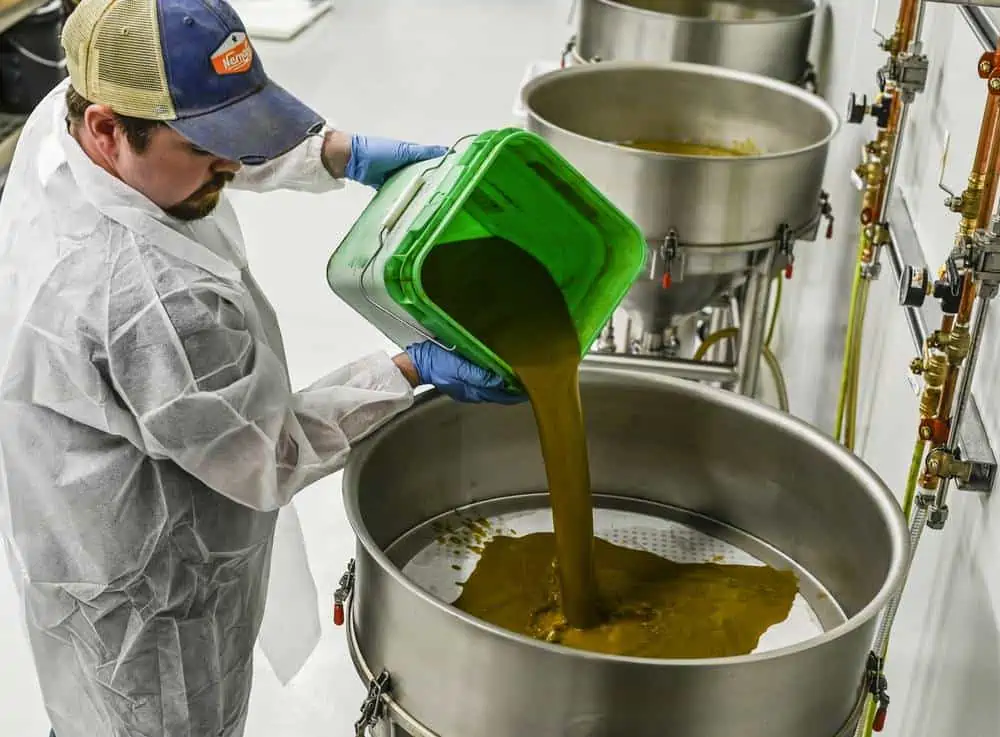
How Winterization is Performed
This process is performed by combining the crude oil with food grade ethanol and then chilled down to -20 degrees Celsius. Once the fats and waxes have collected under the cold temperatures, winterized oil is added to a vacuum filtration system that will pull the oils intended for product formulation through a filter media leaving all the excess plant materials behind.
This is an important step in CBD post processing – primarily for end user satisfaction. The fats and waxes when left in the extracts can cause irritation when vaporized, flavor issues, consistency problems, etc. This applies to all the intended end products created from plant extracts.
Why Winterization is Important
There are other issues associated with these extracts if this process is not performed correctly. Not only do flavor and consistency become impacted by these plant materials, clarity is impacted as well. A clear golden distillate is a benchmark of a high quality extract that consumers are well aware of. Leaving fats and waxes in the final extract can cause a cloudy, discolored distillate that would be undesirable to the end user.
Solvent Removal
For any extraction method, it is essential to remove as much of the solvent used to extract the cannabinoids from the plant out of the final product. This is where the solvent removal process comes into play. By applying heat under vacuum pressure, and creating a thin film of oil on an evaporative surface, the solvent in the mixture can be removed without damaging the cannabinoids and terpenes in the extract.
Because terpenes and cannabinoids can degrade under heat, the need for vacuum pressure and thin film is necessary for this step. The thin film distillation process can be performed by a few methods and several pieces of equipment:
Calculate Your extraction Business Operating Cost
Starting a extraction Business? Check out our Calculators and to analyse costs, estimated revenue, yield, initial investments and important metrics for your extraction business.
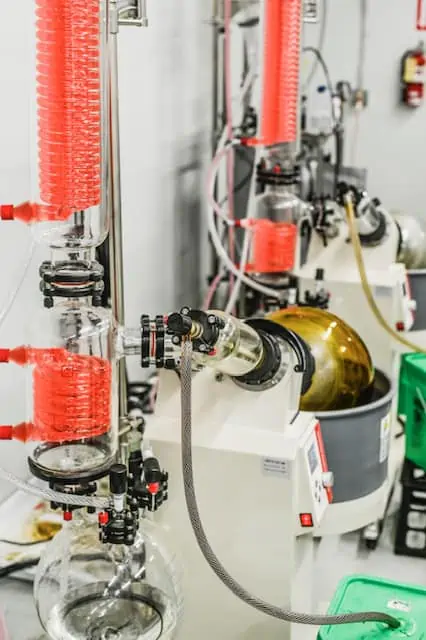
Rotary Evaporators
One of the most common pieces of equipment for solvent removal is a rotary evaporator, commonly referred to as a “rotovap.” This equipment consists of a large, round bottom flask that is immersed in a heating bath as it rotates. This allows for a thin film of oil to be made along the inside of the flask where the volatile substances can evaporate before being collected in a chilled condenser connected to the equipment.
Solvent Removal Under Vacuum Pressure
This entire process is performed under vacuum pressure. The reason for this is to avoid damaging the extracted cannabinoids and terpenes at higher temperatures. The incorporated vacuum pump decreases the necessary temperature to evaporate the solvent from the extract.
Coupling the vacuum pressure with the thin film created by the rotating flask further increases the ability to evaporate the solvent without damaging the cannabinoids and other desired plant materials. A thin film can also be incorporated in another solvent removal system called a falling film evaporator – more on that later.
Popularity of Rotovaps and Common Issues
Though rotovaps are commonplace in the extraction industry, they are not without some issues. Perhaps the most prevalent issue is the large amount of glassware that comes with a rotovap system. Not only is the large round bottom flask prone to breaking, the condenser can be brittle as well, especially under the chilled conditions needed to collect the evaporated solvents.
Another issue with rotovaps is the ability for large scale solvent removal. For any extraction operation of size, it is likely that a number of rotovaps are used in order to keep up with the necessary solvent removal to keep up with the extraction throughput.
For example, a typical rotovap system has an average throughput around 5-10L/hr. This often means that a sizable operation may need anywhere from 5 to 10 rotovaps just to keep up with the extraction output requiring comparable solvent removal. This is where large scale solvent removal solutions like the falling film evaporator begin to shine.
Falling Film Evaporators
In essence, the same basic principles that apply to rotovaps apply to falling film evaporators for solvent removal. Both operate under vacuum pressure, create a thin film and apply heat to evaporate the solvent from the desired extracts. The primary difference between them, however, lies in the method to create the thin film needed to evaporate the solvent without damaging the other components.
Where a rotovap uses a rotating flask that creates a thin film along the inside of the surface, falling film evaporators use an evaporating column that feeds the solvent/extract mixture so that it falls down the inside of the heated column in a consistent, thin film. Because the surface area is higher, the overall throughput and solvent evaporation is increased making it a viable option for larger scale extraction operations.
Most falling film evaporators have a series of metal tubes inside of the evaporation column. These tubes provide heat as the solvent/extract mixture flows through the column. The most common single stage falling film evaporators have a set temperature setting that can be used to evaporate the solvents from the extracts.
This is where the topic of multi-stage falling film evaporator solutions come into play. As the mixture of solvent and extract begins the process of evaporation, the minute traces of solvent become harder to remove. With a single stage system, the mixture may need to be run through the column multiple times in order to remove the final traces of solvent.
This means removing the mixture, introducing it to the possibilities of contamination or breakage before being reintroduced to the solvent removal column. To avoid all of this, systems like the extraktLAB fracTron shine. While single stage systems struggle to accomplish full removal of solvent because of this, extraktLAB’s fracTron utilizes a triple pass falling film system to change the operating temperature of the evaporator as the composition of the liquid mixture changes.
Having the ability to run your mixture through three separate evaporation phases in a single pass allows you to adjust temperatures to best remove the final amounts of solvent from your extract. As viscosity increases through each individual phase, the exact necessary settings needed to create the best extracts can be dialed in in a way that single stage falling film evaporators or rotovaps just can’t accomplish effectively.
Rotovaps vs. Falling Film Evaporators
Where a rotovap uses a rotating flask that creates a thin film along the inside of the surface, falling film evaporators use an evaporating column that feeds the solvent/extract mixture so that it falls down the inside of the heated column in a consistent, thin film. Because the surface area is higher, the overall throughput and solvent evaporation is increased making it a viable option for larger scale extraction operations.
Most falling film evaporators have a series of metal tubes inside of the evaporation column. These tubes provide heat as the solvent/extract mixture flows through the column. The most common single stage falling film evaporators have a set temperature setting that can be used to evaporate the solvents from the extracts.
How Falling Film Evaporation Works
This is where the topic of multi-stage falling film evaporator solutions come into play. As the mixture of solvent and extract begins the process of evaporation, the minute traces of solvent become harder to remove. With a single stage system, the mixture may need to be run through the column multiple times in order to remove the final traces of solvent.
This means removing the mixture, introducing it to the possibilities of contamination or breakage before being reintroduced to the solvent removal column. To avoid all of this, systems like the extraktLAB fracTron shine. While single stage systems struggle to accomplish full removal of solvent because of this, extraktLAB’s fracTron utilizes a triple pass falling film system to change the operating temperature of the evaporator as the composition of the liquid mixture changes.
Having the ability to run your mixture through three separate evaporation phases in a single pass allows you to adjust temperatures to best remove the final amounts of solvent from your extract. As viscosity increases through each individual phase, the exact necessary settings needed to create the best extracts can be dialed in in a way that single stage falling film evaporators or rotovaps just can’t accomplish effectively.
Distillation
The process of distillation is simply the separation of two substances by manipulating their boiling points. In order to do this, the same basic equipment applies that were used to perform solvent removal: a heated evaporator, a condenser, and a method of creating a thin film. That last part becomes incredibly important when creating high quality CBD extracts at a high cannabinoid percentage in the 90+% range.
Distillation has been used for many years in the botanical extraction industry and many of the same principles apply to the cannabinoid extraction industry. Most of these techniques fall under the category of “short path distillation” simply meaning that the evaporated extract travels a short distance from the evaporation medium to the chilled condenser. This increases overall yield and decreases potential issues that might occur in the process.
One of the primary differences between solvent removal and distillation is the increased viscosity of the extracts. This means that typical methods of creating a thin film like gravity with a falling film evaporator, or a rotating flask like a rotovap will no longer create the same thin film necessary to evaporate the desired components. This is where specialized equipment like a wiped film evaporator becomes important.

Short Path Distillation vs. Solvent Removal
Distillation has been used for many years in the botanical extraction industry and many of the same principles apply to the cannabinoid extraction industry. Most of these techniques fall under the category of “short path distillation” simply meaning that the evaporated extract travels a short distance from the evaporation medium to the chilled condenser. This increases overall yield and decreases potential issues that might occur in the process.
One of the primary differences between solvent removal and distillation is the increased viscosity of the extracts. This means that typical methods of creating a thin film like gravity with a falling film evaporator, or a rotating flask like a rotovap will no longer create the same thin film necessary to evaporate the desired components. This is where specialized equipment like a wiped film evaporator becomes important.
Wiped Film Evaporators
Wiped film evaporators operate in the same fashion as other distillation systems, but the method to create a thin film is reliant on a set of wiper blades that spread the oil across the evaporative surface of the column. The reason for this is that the oil will become increasingly difficult to work with the more refined it becomes. The wipers in the wiped film evaporator are capable of creating the film despite the increasing viscosity as the distillation process goes forward.
Because creating distillate is one of the final steps to creating a CBD product, the process has to be dialed in to perfection. This is why a wiped film evaporator shines. This method is crucial for reducing the amount of time the distillate spends on the heated evaporative surface. Using a quality system that is capable of evaporating the desired cannabinoids and terpenes without spending too much time on the heated surface. This ensures a product that has better clarity, color and flavor that will fetch a better market price.
Similar to the fracTron, extraktLAB saw the issues of common single stage wiped film distillation systems and introduced the clearSTILL to the market. Where further distillation may require multiple passes, the clearSTILL uses a dual-stage distillation system that performs two distillation cycles in one pass. This greatly increases the clarity, color and overall purity of the extracts compared to other systems that do not utilize this technology.
The fracTron and the clearSTILL
Similar to the fracTron, extraktLAB saw the issues of common single stage wiped film distillation systems and introduced the clearSTILL to the market. Where further distillation may require multiple passes, the clearSTILL uses a dual-stage distillation system that performs two distillation cycles in one pass. This greatly increases the clarity, color and overall purity of the extracts compared to other systems that do not utilize this technology.

Chromatography & Remediation
Chromatography is a separations method used to separate the various compounds inside of any particular solution. In the extraction industry, this allows processors to separate any of the individual compounds of the hemp plant to create specially formulated products that are considered legal and specific to customer desire.
There are a number of laws and regulations that inhibit the inclusion of psychoactive cannabinoids. For example, the FDA has a strict regulation in the United States that mandates the amount of delta-9 THC be below 0.3% in any CBD product for it to be considered federally legal. What chromatography can do is take a distillate that has too high of a THC content and remediate that THC in order to formulate a legal product.
While this is essential for legal reasons, it is just as critical for the demands of customers. Many regular users of CBD products have a set standard of both quality and cannabinoid content. Chromatography is not only capable of isolating particular cannabinoids for product formulation, but is also able to remediate unwanted residuals such as pesticides or other compounds. As customers continue to vie for organic products, these remediation techniques become even more important in order to meet market demands.
Chromatography is also incredibly useful for testing. Because it is essential that your extracts are of the purest standard, ensuring that no residual solvents, pesticides, or psychoactive materials are in them is essential. Chromatography is capable of detecting and identifying unknown residuals that could otherwise be left in an extract. Once they are identified, they can be remediated.
One particular issue with standard preparative chromatography methods is scalability. This is often due to the quantity of liquid solvent necessary to do this method on a large scale and the solvent recovery process. The costs associated with the use of this much solvent can be monumental.
extraktLAB saw this common issue and introduced the pure99 chromatography system. Using a closed loop technology, the pure99 is the first scalable chromatography solution that is designed to automatically recover excess volatile eluent during the process.
This allows the liquid eluent to be recycled back into the column of the pure99 using an onboard gas counterflow distillation method. The merging of fractional distillation and large scale chromatography has made the pure99 the most efficient, scalable solution in the extraction industry.
The Legal & Personal Reasons for Chromatography
There are a number of laws and regulations that inhibit the inclusion of psychoactive cannabinoids. For example, the FDA has a strict regulation in the United States that mandates the amount of delta-9 THC be below 0.3% in any CBD product for it to be considered federally legal. What chromatography can do is take a distillate that has too high of a THC content and remediate that THC in order to formulate a legal product.
While this is essential for legal reasons, it is just as critical for the demands of customers. Many regular users of CBD products have a set standard of both quality and cannabinoid content. Chromatography is not only capable of isolating particular cannabinoids for product formulation, but is also able to remediate unwanted residuals such as pesticides or other compounds. As customers continue to vie for organic products, these remediation techniques become even more important in order to meet market demands.
Using Chromatography for Testing
Chromatography is also incredibly useful for testing. Because it is essential that your extracts are of the purest standard, ensuring that no residual solvents, pesticides, or psychoactive materials are in them is essential. Chromatography is capable of detecting and identifying unknown residuals that could otherwise be left in an extract. Once they are identified, they can be remediated.
One particular issue with standard preparative chromatography methods is scalability. This is often due to the quantity of liquid solvent necessary to do this method on a large scale and the solvent recovery process. The costs associated with the use of this much solvent can be monumental.

The pure99 Chromatography System
extraktLAB saw this common issue and introduced the pure99 chromatography system. Using a closed loop technology, the pure99 is the first scalable chromatography solution that is designed to automatically recover excess volatile eluent during the process.
This allows the liquid eluent to be recycled back into the column of the pure99 using an onboard gas counterflow distillation method. The merging of fractional distillation and large scale chromatography has made the pure99 the most efficient, scalable solution in the extraction industry.
Ask our industrial hemp experts to determine what type of hemp processing and hemp extraction equipment is best suited for your business.
Isolation
The isolation process is the final stop before product formulation and creates a CBD product in the 99% purity range. This step removes every other plant material from the extract including terpenes, cannabinoids and any other excess material that may be present. While this may negate the “Entourage Effect,” it allows for products that are as pure as they can be for their intended cannabinoid profile and appeals to the user who wants to avoid full spectrum products. Isolation is performed by taking CBD oil and stirring it inside of some form of reactionary vessel.
The next part of the process has everything to do with temperature. As the oil is being stirred, the temperature is gradually decreased along with the rate of stirring. This allows for a process called nucleation to begin the crystallization of the oil.
After this step has started, the stirring rate is sharply increased to separate the newly formed crystals from the solution. After they have been fully separated, the crystals are washed with a chemical solvent like pentane to remove the final trace impurities leaving a 99% pure CBD isolate.
These products have become increasingly popular particularly in areas that do not allow for psychoactive cannabinoids in a final product. Because isolate is a pure formulation, it also allows for particular product formulations that can focus primarily on the benefits of a single cannabinoid.
There are many customers who have to entirely avoid psychoactive cannabinoids, either to avoid the mind altering effects, or to avoid a positive drug test, and there are more customers still that find specific benefits from individual cannabinoids. This is where isolate really shines.
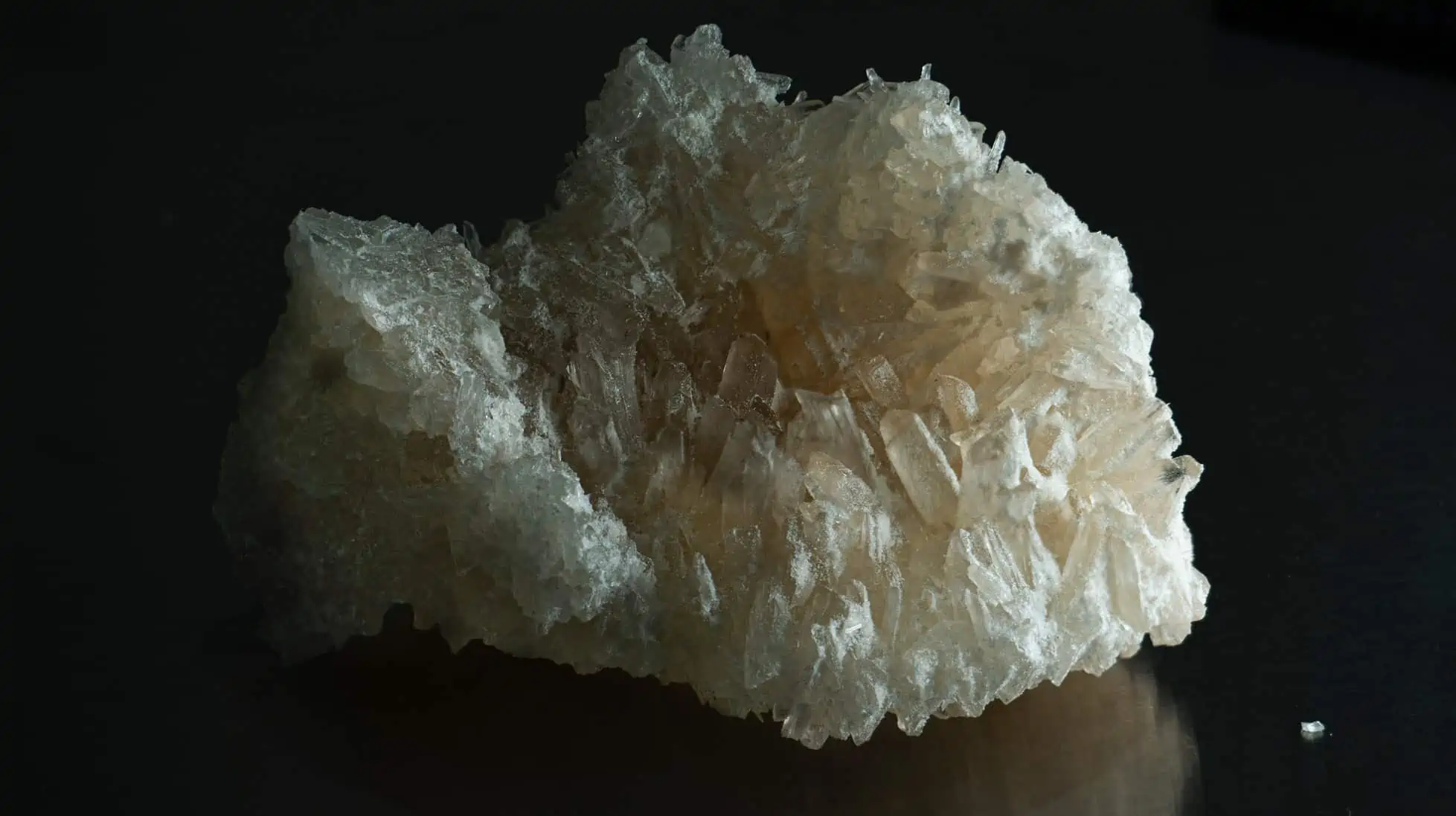
How Isolation is Done
Isolation is performed by taking CBD oil and stirring it inside of some form of reactionary vessel. The next part of the process has everything to do with temperature. As the oil is being stirred, the temperature is gradually decreased along with the rate of stirring. This allows for a process called nucleation to begin the crystallization of the oil.
After this step has started, the stirring rate is sharply increased to separate the newly formed crystals from the solution. After they have been fully separated, the crystals are washed with a chemical solvent like pentane to remove the final trace impurities leaving a 99% pure CBD isolate.
Where Isolate Products Shine
These products have become increasingly popular particularly in areas that do not allow for psychoactive cannabinoids in a final product. Because isolate is a pure formulation, it also allows for particular product formulations that can focus primarily on the benefits of a single cannabinoid.
There are many customers who have to entirely avoid psychoactive cannabinoids, either to avoid the mind altering effects, or to avoid a positive drug test, and there are more customers still that find specific benefits from individual cannabinoids. This is where isolate really shines.
Final Thoughts
Post-extraction processing is absolutely essential when creating CBD products intended for store shelves that customers will want to buy. Without the refinement process, you are limiting yourself to business to business wholesale crude oil. If this is not your intention, then dialing in the steps discussed above are key to creating great CBD products that will stand apart from the competition. If you are interested in taking your post-extraction processing to the next level, contact us for consultation, or to decide what equipment will make your operation as efficient as possible today.
Supercritical CO2 Machine Product Tour
Get access to extraktLAB’s line of supercritical CO2 extractors which considered as the highest in quality, efficiency and GMP compliance in the hemp extraction industry.
Frequently Asked Questions
Is isolate organic?
Because isolate is created using a solvent like heptane for a washing medium, it can no longer be considered an organic product like full spectrum extracts. That said, it is still absolutely safe to use.
What limits the amount of THC allowed in an extract?
The 2018 Farm Bill set forth by the FDA legalized the production of hemp, but included legislation that indicated a THC level of 0.3% or more would be legally considered marijuana due to the potential psychoactive effects.
What is the benefit of having a dual stage wiped film evaporator?
A dual stage wiped film evaporator like the clearSTILL allows for a more refined distillation process without having to remove the distillate and reintroduce it for a second pass. Each pass is contained in a single cycle.
Do rotovaps and falling film evaporators have the same throughput?
No, a standard falling film evaporator can replace anywhere from 6-10 rotary evaporators in terms of solvent removal throughput
Is winterization necessary for ethanol and CO2 Extraction
No, because ethanol extraction is performed at very low temperatures, winterization is not necessary. CO2 extraction is performed at higher temperatures and thus requires winterization to properly remove fats and waxes from the final extract.



